You cannot get bored with Norway. This year, we were lucky enough to tour the most northern part of this fantastic country for the first time. We explored the area called ‘Tromso and Finnmark.’ Northern Norway is full of spectacular places. We spent two months here, with a motorhome and two small children. This post will tell you about the first part of the Norway road trip, the section from Kirkenes to Nordkapp. Of course, we made many detours and hikes and enjoyed every day of the wonderful fjords, wildlife, and the chilly summer.
Last year, we were on a similar but only three-week Norwegian road trip in the south of the country, visiting several child-friendly attractions in addition to the popular hiking destinations like Pulpit Rock and less touristy places. Now it was time to go off the map. Travel Northern Norway with us!
Northern Norway Attractions
What to do in Northern Norway? Northern Norway is full of spectacular but small fjords, cute animals (like reindeer!), and vast lands without much human disturbance. This summer, we departed on a journey from Kirkenes through Nordkapp to Lofoten. This post is about the first part of the road.
Grense Jakobselv – A day trip from Kirkenes
Before discovering Kirkenes, we first headed to the easternmost point of mainland Norway near the Russian border. The journey took more than an hour, despite being only 54 km from Kirkenes. Along the way, we also passed the country’s oldest log mountain, which included a small hike. Although it was rainy, as so many times before, it thankfully didn’t deter us from exploring the area. Grense Jakobselv is at the end of the world.
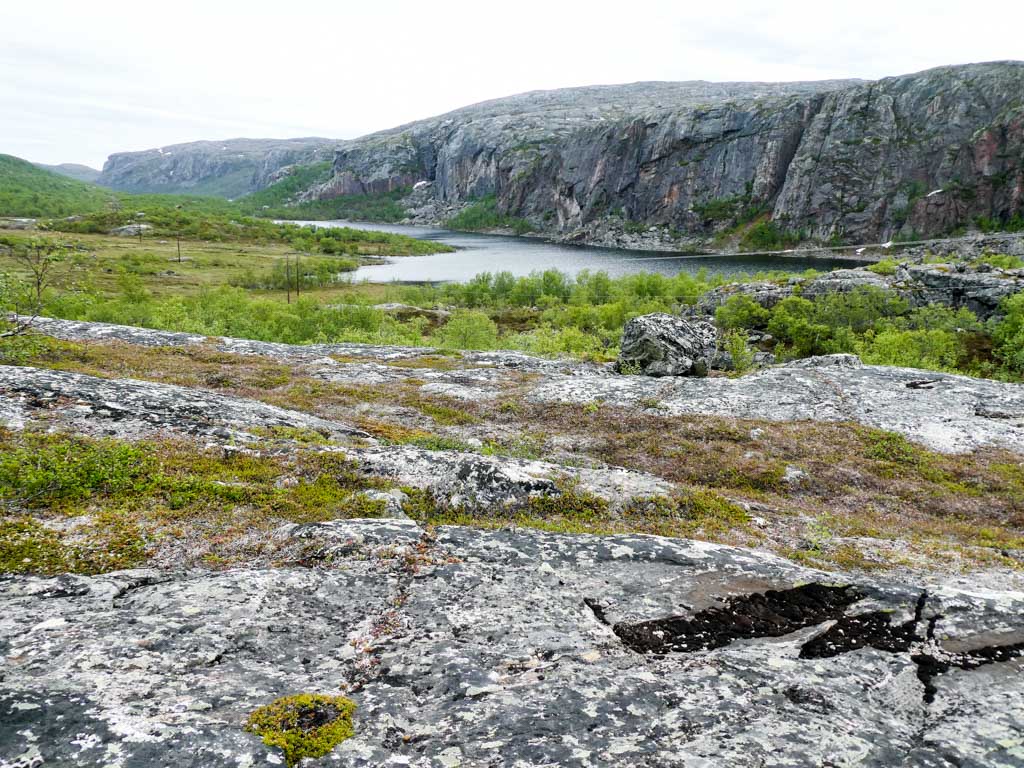



King Oscar II Chapel

The town of Grense Jakobselv consists of just a few distant houses and this beautiful church. The latter was the main reason we came here. The Chapel of King Oscar II (King Oscar II Chapel in English, Kong Oscar II Chapel in Norwegian) is a stone church erected to avoid former border disputes. It is definitely a better solution than sending warships to the area, which has also been raised to deal with the locals’ ongoing conflict.
It is also worth visiting the small cemetery, where the tombstones testify to the four nations that live here. Although we see Norwegian names on most of the tombs, many Russians, Finns, and Sami have also found their final rest here.


Here we spent a few nights at the end of the world, listening to the chirping of seagulls and the waves of the Barents Sea crashing a few meters from the motorhome. You can also swim on the beautiful sandy beach next to the small harbor, but you should be prepared for the cold water. The sea stays pretty cool even in summer.
The 96-høyden Tower

Another attraction near Kirkenes is the 96-høyden tower next to Svanvik, which offers beautiful views of the hills and the Russian industrial city of Nickel across the border. Although we couldn’t go up to the tower because of the virus situation, we could still look around a bit.

3-point-border and the Øvre Pasvik National Park
You can also hike to the triple border point along with the border posts. We missed this adventure as it would have been a very long and monotonous walk with the two little babies on our backs, plus the views were less spectacular than a couple of other places we did hike. Just think about the beautiful Segla or the views of Lofoten. While driving through the National Park, we could also find many military objects as it is literally next to the Russian border.
Murmansk (Russia)
Murmansk is also a place on our bucket list, we couldn’t go across the border this time, but we have not given up the idea yet. Fortunately, the city is also relatively easily accessible from Rovaniemi and Finnish Lapland.
Kirkenes Sightseeing
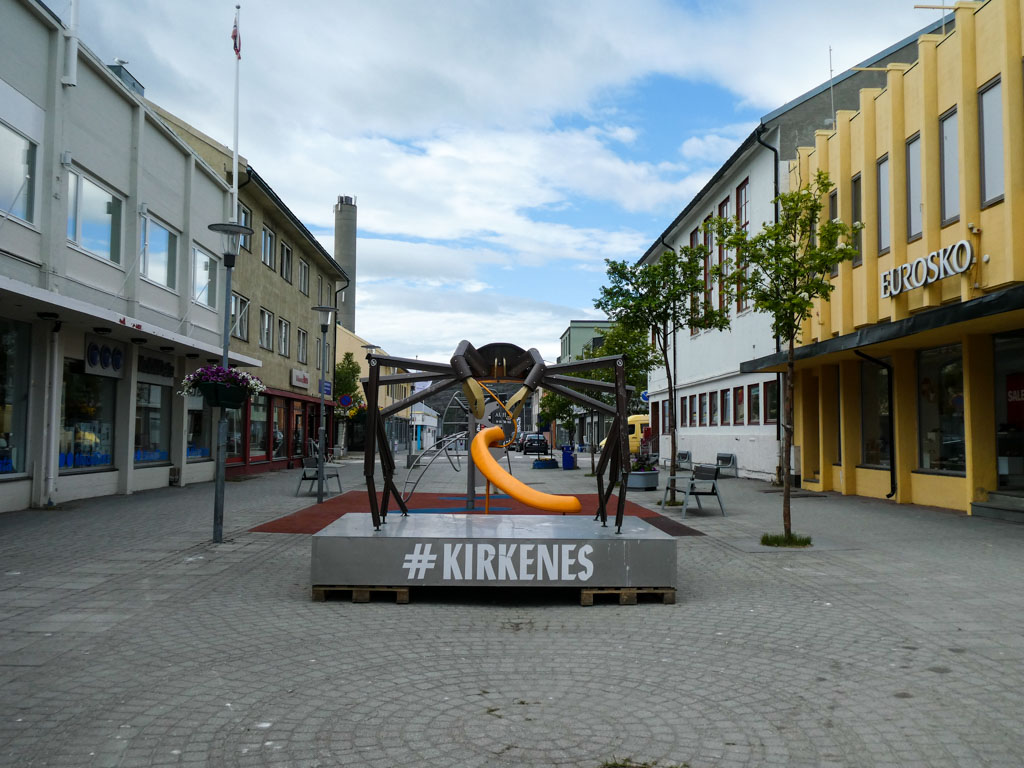
We had been in Norway for a week before we finally reached Kirkenes, a peninsula next to Bokfjord on the Varangerfjord, 400 kilometers north of the Arctic Circle. By the time we got there, we were completely accustomed to the seagulls we listened to day and night, whether outside the car or inside. Our visit’s only downside was the weather: a couple of windy and rainy days mixed with pleasant ones. Make sure to pack an umbrella for sightseeing as the weather was really unpredictable.

Kirkenes is a surprisingly small industrial city with a population of just 3,500. The town recalled my former high school geography lessons. I’ve always wanted to visit it with its Swedish ‘sister’, Kiruna (ed.: and both are already crossed out on our bucket list). The city’s view has changed a lot in recent decades, but it is still full of colorful (twin) houses built of wood. This was quite surprising, but after some thought, it isn’t so surprising. Probably the workers had to share finite accommodations, and although the city developed, it kept that characteristic.
The settlement’s port has a significant economic role due to the Northeast Passage, which connects Europe and Siberia with China. We saw plenty of fishing boats and fishing nets around the harbor during our days here.

In World War II, it was one of the most air-stricken cities globally, with 1000 alarms and 320 rocket attacks on the then inhabitants, while the Nazi army used Kirkenes as a base. Only 13 buildings survived the devastation of World War II.

The World War II refuge, Andersgrotta, where the city’s residents hid during the strikes, serves as a museum and is one of its most famous sights. Another famous place in Kirkenes is the SnowHotel, located 8 kilometers from the center and can be visited during the winter season.
In the parking lot next to the church and the police, we found a super place where we spent several nights overlooking the Kirkenes fjord (Kirkenesfjorden). The top-class hotel next to us (Thon Hotel) ) would have cost almost 600€ a night if we wanted to take out two rooms for our family. Needless to say, again, a big plus point for traveling with an RV.
Fortunately, there are also cheaper places in the city. From here, you can find hostels and hotels within a few minutes at more affordable prices, although personally, I would rather stay at the Scandic Hotel because the hostels have pretty bad ratings.


The city was extremely windy, but as we looked at the annual weather averages, it is completely normal. Nevertheless, we also hiked around the city a bit. The hills south of the city center next to the Varanger Museum (Grenselandmuseet in Norwegian) were a good choice. There were fantastic views of the flat fjords (Bokfjord and Kirkenesfjord) that surround the city. A smaller peninsula also belongs to the city. We also explored it another day.
Bugøynes – Pykeija, Little Finland
We headed west. Bugoynes is a must-stop for those interested in a small Finnish (!) Village here in the middle of nowhere. The Finnish name of the place is Pykeija. Norwegians founded the settlement in the 17th century but soon became abandoned, and then nearly a hundred years later, the Finns moved here. It was only accessible by sea for a very long time, but fortunately, there is already a road here.
Although the small fishing village barely counts 200 people, the Finnish population’s proportion is still significant today, often referring to the settlement as Little Finland. Probably it is more interesting to those like us who have some connections to Finland. Another special feature is that it is one of the few villages that was not burned down during World War II.
Varangerhalvøya National Park
After Varangerbotn, we headed north to see this barren, tree-free Varangerhalvoya National Park, at least from the edge. We planned hiking too, but the flat hills, the strong wind (20-30 km/h), and the cool weather (most of the time, it wasn’t much more than 10 degrees Celsius) made us change our minds. Fortunately, there are several easily accessible attractions along the beach. These were our favorites.
Vadso (Vadsø)

Our first stop was on the small island of Vadso. Although we haven’t really met people in the settlement, it was pleasant to walk both on the island and in the part of the settlement that has spread to the mainland.


The “harbor” of the airship is the biggest attraction of Vadso, located next to an old fortress’s remains on the east side of the island. Airships flying to Alaska were able to stop here. Besides, even the church is worth seeing, at least from the outside. Norwegian churches are so unique!.
If you need accommodation in Vadso Airbnb or Vadsø Fjordhotell


Ekkerøy Coastal Fort
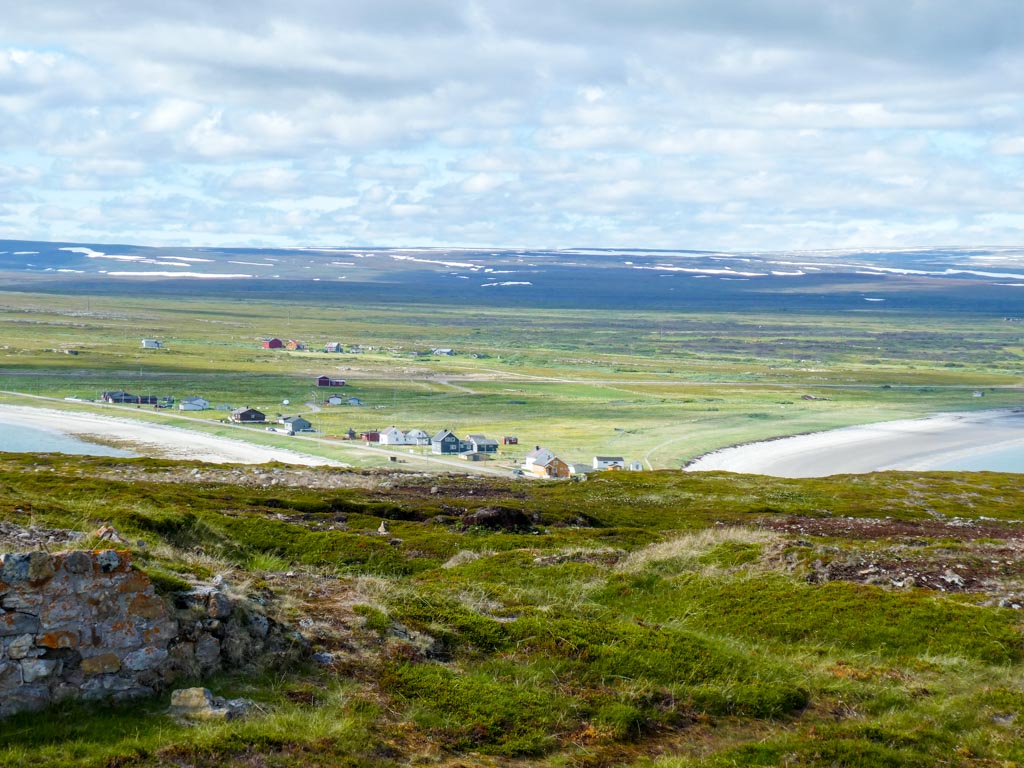
If you just want to visit only one fortress that looks good and has a better view, are sure to choose Ekkerøy. Almost the entire peninsula belongs to the former fortress, with only a few streets on the side closer to the mainland. Although we visited it in July, the surrounding mountains and hills were still covered with quite a bit of snow.


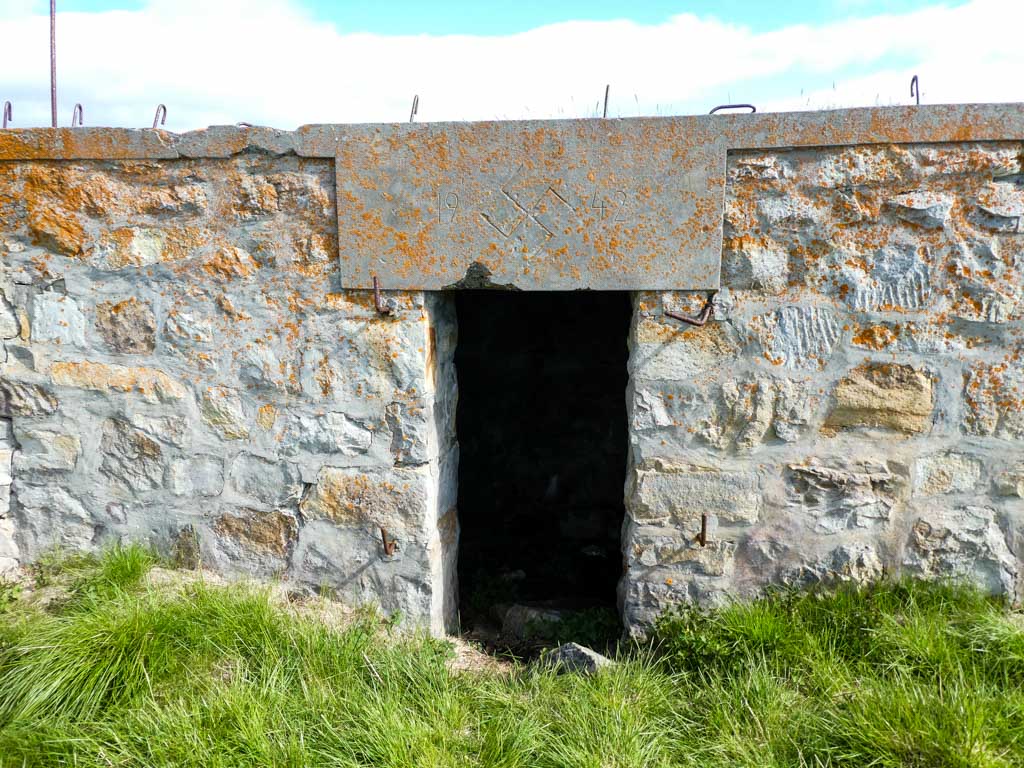








Ekkeroy Bird Colony- Ekkerøy Fuglefjell



Perhaps the best place we visited in this area was the Kittiwake (seagull) birds’ home. The Ekkeroy Bird Colony. It is also located in Ekkerøy, on the steep rock walls below the fort, just a few minutes ’walk from the car park. Thousands of birds nest in this area. It was amazing to see and hear them: some flew in teams while others rested peacefully in the nest. We also recorded a video of them. Check it out!
VIDEO
Vardo (Vardø)

Vardo is the easternmost town in Norway, east of Kirkenes, and east of St. Petersburg in Russia or Istanbul in Turkey. You can approach it through a tunnel. There is also the Globus II radar system, which officially deals with space junk detection. Still, due to Russia’s proximity, other things often arise, such as an element of the U.S. anti-missile system. Here and around Grense Jakobselv, the GPS positioning of phones is often disturbed for security reasons.

Vardøhus Festning




The former fishing village is also becoming more and more open to tourism. Vardø’s tourist attractions include Vardøhus Festning, a 14th-century fortress whose current buildings date from 1734. Vardøhus Festning is also home to two rowan trees that are carefully cared for and heated in winter, as trees are usually unable to survive in Vardø’s climate, north of the Arctic tree line.
Steilneset Minnested

In addition to the colorful wooden buildings, the church, and the chapel, the monument to the witchcraft trials is the newest attraction of the town Steilneset Memorial is a monument in Vardø, Norway, commemorating the trial and execution in 1621 of 91 people for witchcraft. If you go to Vardo, don’t miss it. The long boat-like statue commemorates many victims, and you can read their story in the little English-language booklet.




From Vardo, you can also get to Bird Island (Hornøya), which is home to about 80,000 seabirds.
Accommodation in Vardo: Airbnb or Vardø Hotel
Hamningberg and the National Tourist Route

We continued to die for Hamningberg. This road stretch is so spectacular that it has also been awarded the title of “National Tourist Route.” Norway’s spectacular roads include 18 routes, such as Lofoten, Senja, or the Geiranger-Trollstigen road, so we were guaranteed not to disappoint us.

We were also intrigued by the fact that this was a deserted fishing village – but that didn’t turn out to be so true. They may not have a permanent residence (or not many) here, and we have also seen many new houses being built in the settlement. Nevertheless, we did not regret taking on this one-hour drive on the winding but extremely spectacular rock-lined beach route.

Besides, we met hundreds of reindeer both on the road and with a dozen in the village. In fact, the whole peninsula is the perfect place to see these beautiful animals as there are no trees on it, so they can’t really hide from travelers’ curious eyes.


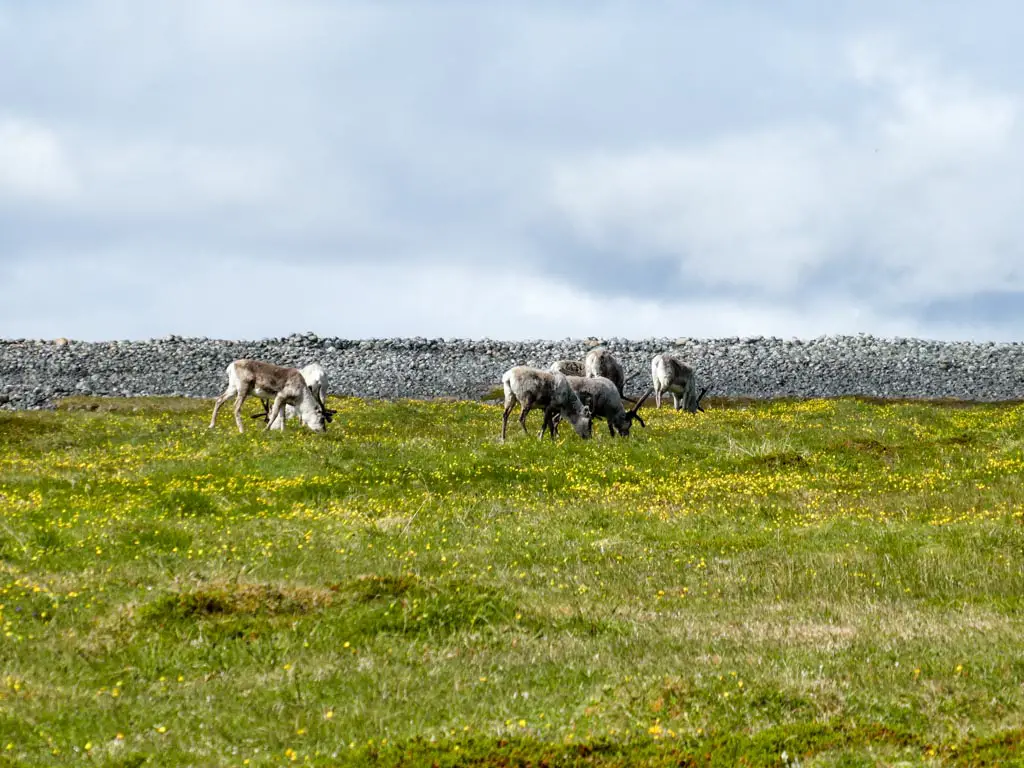






We also climbed to the remains of another World War II bunker above the village, from where there was a beautiful view of both the houses and a small lighthouse. The view was worth the short walk. It takes about half an hour each way following the dirt road marked with the sign, but of course, we stayed a little longer here as well.
You can find accommodation here in this not-so-deserted but spectacular village in Northern Norway.
Tanahorn
It is also worth going to the northern part of the peninsula because of the town of Batsfjord and Tanahorn. For those who like to hike and don’t mind the bumpy roads, we strongly recommend it.
Towards Nordkapp

Although we could spend even more weeks in this area, we then headed for Nordkapp. Besides checking the northern tip of Nordkapp Island, we also stopped at many places along the way, but I will talk about them in another post.
Practical Info for Those Who Travel in Northern Norway and Kirkenes
Travel Resources
There is nothing better than a relaxed holiday. To ensure your rest, make sure you reserve and book your accommodation and transportation in advance of your trip.
- Book a small group of private tours with us at amazinglapland.com to make your experience magical in Lapland.
- Don’t forget to insure yourself during your travels: SafetyWing. Check out their policies HERE. It also covers several virus-related expenses.
- Look for the best prices on flight tickets, hotels, and car rentals: Expedia
- Car rental: SIXt
- Accommodation: Booking.com, Agoda or Hostelworld if you travel on a budget. Don’t forget that you can search for Apartments also on Booking.
- Activities: GetYourGuide
- Opinions on hotels and restaurants: TripAdvisor
- Was your flight canceled or delayed? Get up to 600€ back with the help of Compansair!
Car Rental
Although we traveled in our own RV, most tourists rented a car in Kirkenes and toured the area with it. If you just don’t want to tour all of Norway, this is the most economical solution.
Accommodation
If you opt for the often much cheaper AirBnB accommodation instead of the hotels, take a look around here. You can find Booking.com offers here.
Groceries
Although Norway is an expensive country, it is easy to find cheap things in most supermarkets. Look for the shops’ own brands or ‘Frist Price’ products. For example, a regular loaf of 500-750 grams can easily be 30-40 crowns, but you can get First Price bread for around 7 crowns. (Currently, 1€ is 10.7 Norwegian krone while 1 USD is 9 krone – September 2020)
Pin for later!

About the Author

Katalin
Katalin is a Lapland-based outdoor enthusiast who loves hiking, road-tripping, and traveling with her family. She spends her free time far away from civilization in one of the national parks around the world, explores off-the-beaten-path places, or hops on a road trip with her kids in an RV.
Read more about her adventures and the blog.

